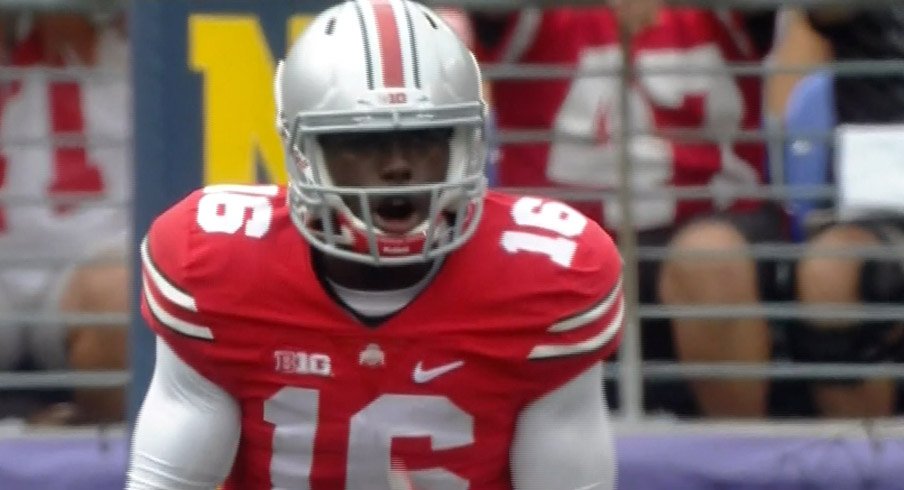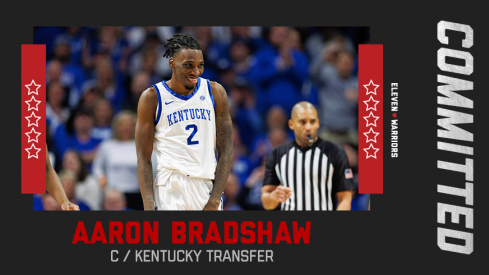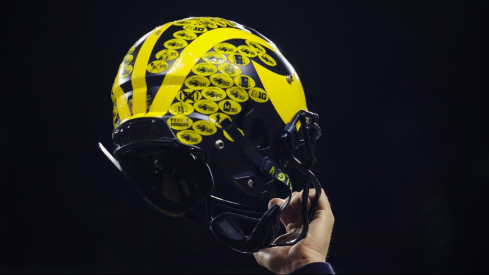On Saturday, Ohio State – perhaps not unexpectedly – performed unevenly before pulling away against Navy. The Buckeyes remained in a tight contest with the Midshipmen due to negative plays hampering promising drives on offense. And explosive plays undermined an otherwise solid defensive effort.
Ohio State put the game away, however, once they limited their mistakes. In so doing they exhibited the potential for growth and helped define several players' roles.
Blast from the Past
New co-defensive coordinator Chris Ash had the unenviable task of opening against Navy's flexbone. Thankfully, that's the last time Ohio State will face the triple option this season, so we should be cautious about drawing broad conclusions. Nevertheless, a few points are worth noting.
Ash's defense unveiled an option-specific scheme. The Buckeyes did not play their base linebackers. Instead, Ohio State lined up in an over defense with two walkout linebackers over Navy's slotbacks. They then rotated their two inside linebackers – Curtis Grant and Josh Perry – at a deep middle linebacker position.
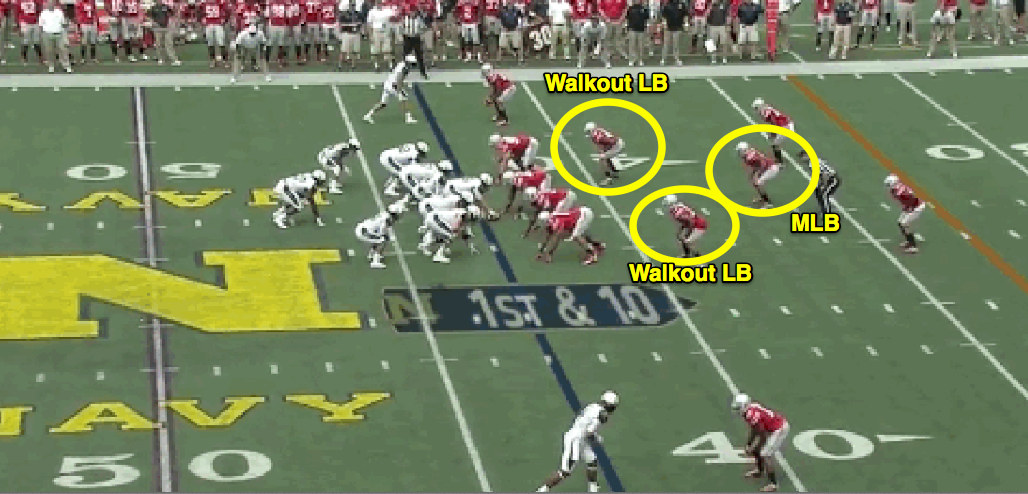
In theory this allowed the Buckeyes to confuse Navy's reads by changing the assignments between the defensive ends, outside linebackers and middle linebackers. More specifically Ash would frequently flip the linebackers roles. The walkout linebacker would play the dive while the Mike would arc around for the pitch.

The Buckeyes' primary focus was taking away the dive and quarterback keep. In this they largely succeeded.
But the schematic choices created two problems. First, the pitch back was all too often unaccounted for.

The Mike would frequently get chipped by an arc block and not get to the pitch.
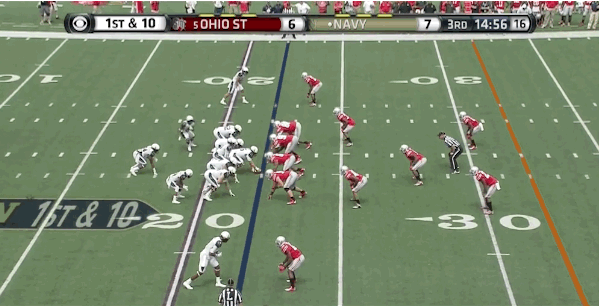
Second, the defense lacked a player to account for the inside counter. The Mike was so quick to get across the field for the pitch that he was easily sealed. Perhaps the backside linebacker and safety should have mirrored the slotback. But this did not occur. It was particularly noticeable when safety Cam Burrows losing backside contain, creating Navy's biggest play.
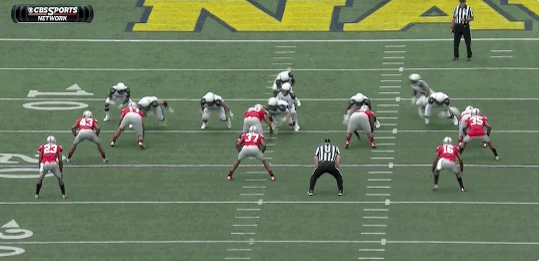
The Eye in the Sky . . .
These scheme-specific issues may not have much application moving forward. But certain strengths and weaknesses for the Buckeye defense were nevertheless displayed. As expected, the defensive line is a clear strength. Nose tackle Michael Bennett and three-technique Adolphus Washington dominated the line of scrimmage. The Buckeyes missed Noah Spence but Rashad Frazier played well in spurts.
In the back seven, Von Bell demonstrated he needs to be on the field. To start the game he and Burrows rotated every two series. But after Navy's long counter run Bell played the rest of the second half. The safeties as a group were slow in rotation, but Bell took proper angles and showed a nose for the football.
It is more difficult to assess the linebackers since they were playing out of position. Perry and Grant still seem hampered by a lack of instincts that make them a step slow to the ball. But their performance improved as the game progressed. Darron Lee made several plays and was around the football, while Chris Worley often looked lost. But again, an assessment as a group will have to wait until they are in their more natural positions.
In sum, it is not worth spending too much time worrying about scheme deficiencies against the Midshipmen because Ohio State will not again face the midline triple option. Ash likely wanted to get through the afternoon without devoting too much practice time to defending one scheme.
And the reality is that surrendering big plays overshadowed a largely solid defensive performance. Navy boasts an experienced group adapt at running the flexbone. So it is no surprise the Midshipmen gained yards.
The Buckeyes had a far bigger mismatch versus the Navy defense. Yet the Ohio State defense largely kept the Buckeyes in the game while the offense shot itself in the foot. The most important example was forcing Navy to punt after the Buckeye offense failed to convert in fourth and short after a mistaken fumble call.
Moving Forward
Against the Buckeye offense Navy utilized its 3-4 front. The Midshipmen regularly deployed their outside linebackers and slot defenders to crash down against the run.
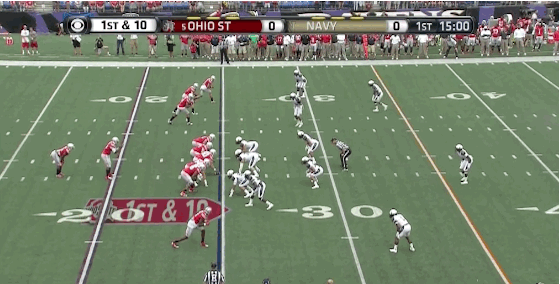
In response, Ohio State opened with a combination of tight zone, lead outside zone to the H-backs Dontre Wilson and Jalin Marshall, and a perimeter passing game.
That offense moved the football throughout the game, with only one three and out. But two problems limited the translation of yards into points.
The first was pass protection. The new Buckeye offensive linemen largely did not struggle with individual blocking.
The breakdowns instead came in understanding who to block. Navy generally sent four rushers. But the fourth rusher came from different spots in their 3-4 defense. The Midshipmen goal was to shoot gaps. In the Buckeyes' five men protection the linemen were potentially responsible for two gaps. All too often Buckeye linemen would allow a rusher to split them, expecting help from their teammate.
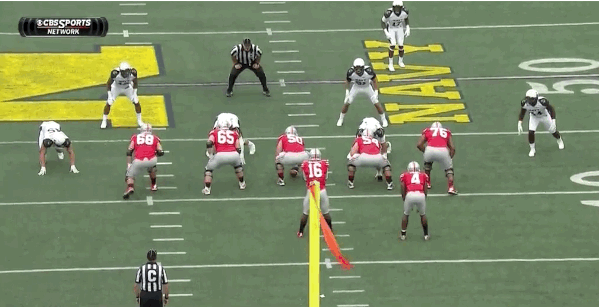
Second, the Buckeyes shot themselves in the foot in the red zone. The Buckeyes had two second quarter red zone drives that resulted in three points. The first ended with a J.T. Barrett interception that resulted from the aforementioned protection problems. The second resulted in a field goal after a large loss on a speed option on third and short. Speed option may have been a questionable call – but one that could have been converted if Barrett kept.
Plugging the Gap
The Buckeyes corrected their protection problems in the second half by including a tight end in the blocking scheme. Again, this was more about ensuring assignments then assisting any individual linemen. By using a six-man protection, the Buckeyes could employ a half-slide protection. The line could now block every gap, allowing each linemen to focus upon a single hole.

Urban Meyer and Tom Herman also settled upon a method to keep Navy's outside linebackers at bay. The Midshipmen edge defenders were not particularly concerned with respecting Barrett as a run threat on tight zone read. This was, of course, never a problem with Braxton Miller.
In response, the Buckeyes sent Wilson or Marshall in jet sweep action, holding the backside linebacker.

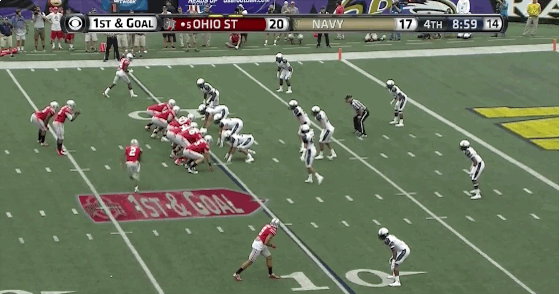
By limiting mistakes the Buckeyes combined tight zone, outside zone, and play action passing to score touchdown on their last three possessions. With only 55 plays the Buckeyes ran 15-20 less then normal. But those plays should have resulted in several more touchdowns.
Four plus Four
The Buckeyes' first game provided an opportunity for the Buckeyes' new playmakers to emerge. In particular, it showcased four inside and four outside players.
As to the former, the Ohio State offense was geared around tailbacks Ezekiel Elliot and Curtis Samuel and H receivers Dontre Wilson and Jalin Marshall. Samuel was impressive in his debut. He keeps his feet moving in the hole, which allows him to exploit his quickness in traffic and makes him an effective inside runner. Elliot was initially sluggish, leaning too far forward when running. But he righted the ship in the second half.
It is clear that Meyer and Herman will seek to utilize Wilson and Marshall as much as possible. With additional weight Wilson looks like a different player. He showed patience on outside zone runs, setting up blocks and then hitting the hole with speed.
Then on the outside, the Buckeyes featured four receivers – Devin Smith, Evan Spencer, Mike Thomas and Corey Smith. These eight skill players along with tight ends Jeff Heuerman and Nick Vannett will form the focus of the Buckeye offense going forward.
Getting your feet wet
Of course, most of the focus was upon Barrett. And he played a solid game in his debut. As a passer, Barrett made good decisions and showed a nice touch. As a runner he was initially too ready to give and not decisive in running north-south. But his running improved as the game progressed. He is not quick enough to run east-west, so he must quickly get upfield and maximize the available yardage.
Barrett's performance should give Meyer and Herman confidence to expand the offense. The Buckeyes left easy yards on the field. For instance, to commit their edge players to the run game Navy's corners provided the Buckeye receivers ample cushion. The Ohio State offense could have taken advantage with backside hitches off tight zone. And the Buckeyes must better take advantage of defenses overcommitting to the run.
At a conceptual level, Meyer and Herman must adjust to Barrett not threatening the defense as run threat the way Miller does. Barrett demonstrated he can gain yards when the defense does not account for him. But teams would likely prefer him carry the football then the other Buckeye skill players. The Buckeyes must continue to utilize Wilson and Marshall both as threats and decoys to hold the defense at bay.
At the same time the Buckeyes must not be overly predictable in their play calling based upon the H's position. For instance the Buckeyes generally ran lead outside zone from a split back look.
And the offensive line must continue to improve in executing pass protection schemes. Bud Foster will deploy a variety of man and zone blitzes with his Virginia Tech defense, rendering pass protection integrity paramount.
